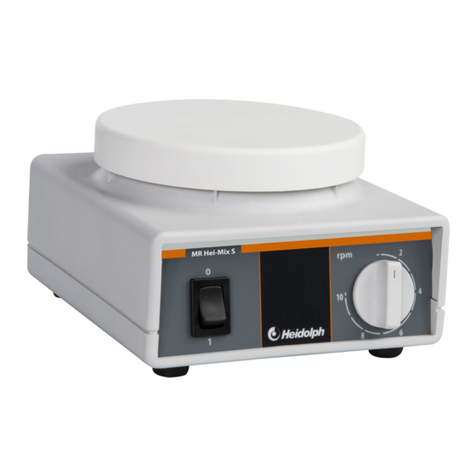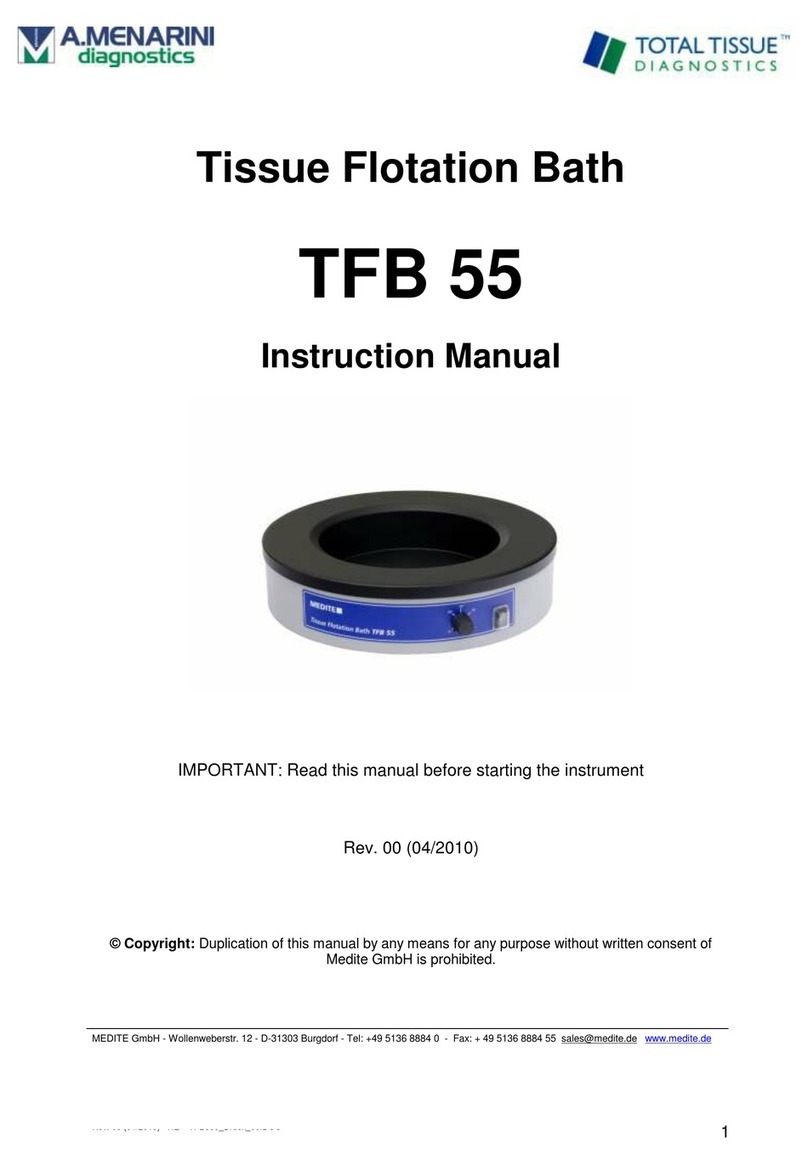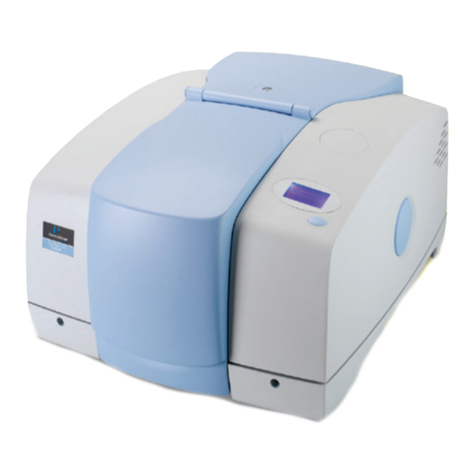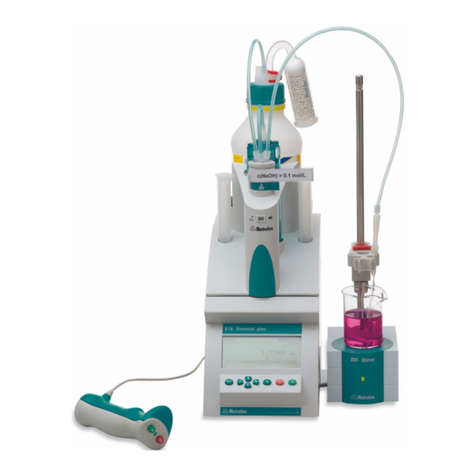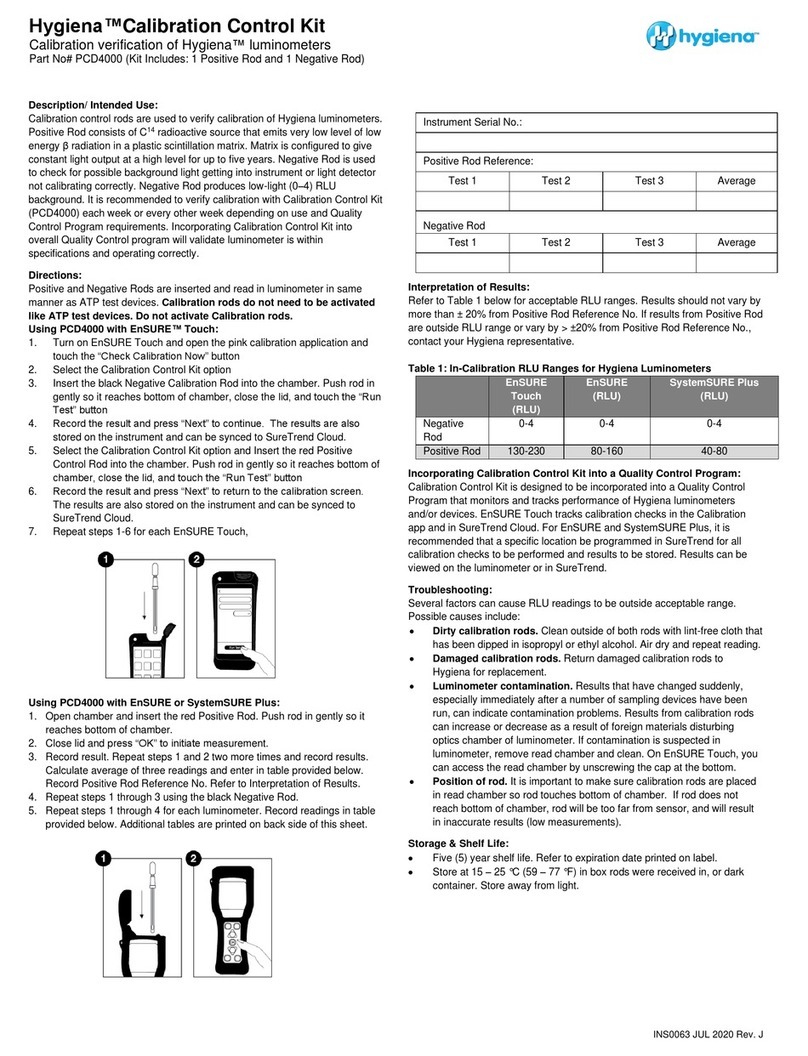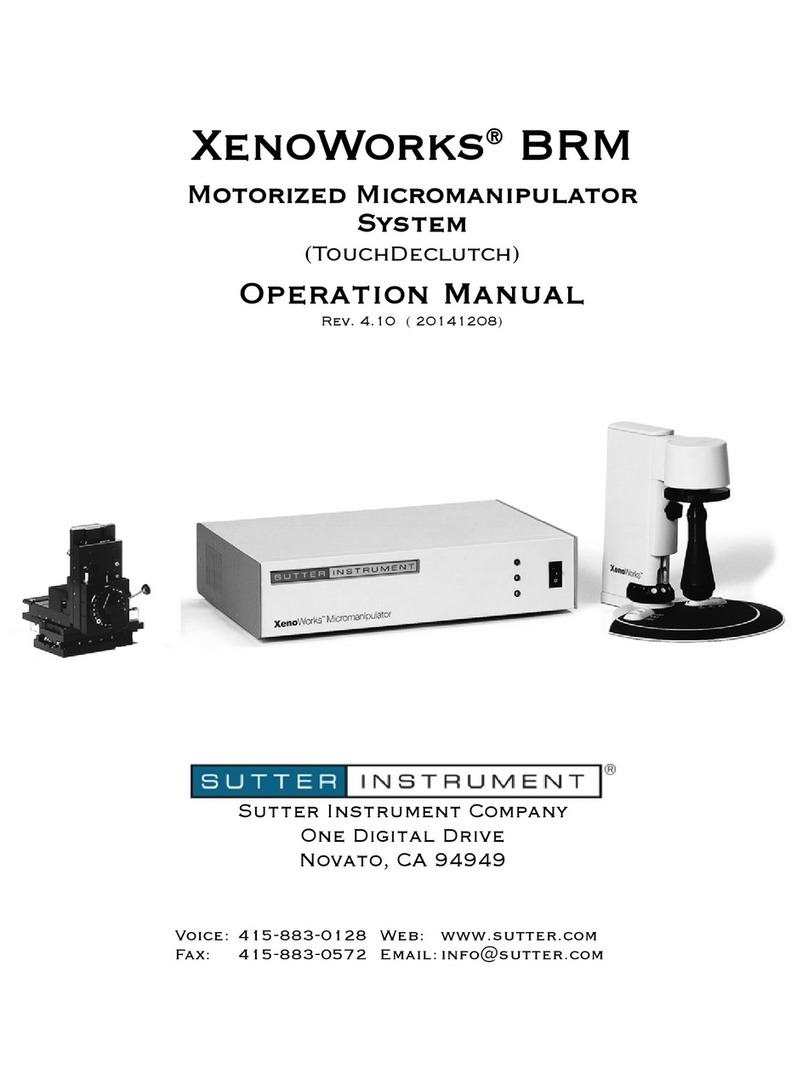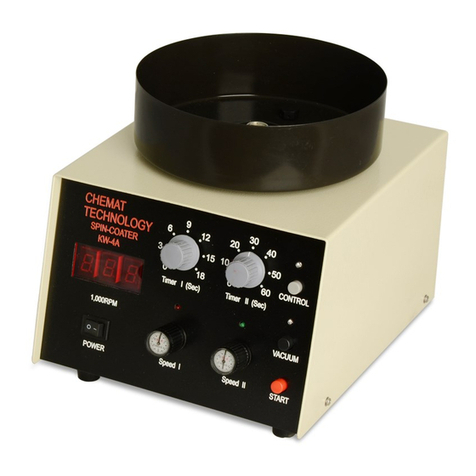Miles Technology Multisonic M44 User manual

Miles Technology Inc. • Niles, Michigan • USA
M44 Multisonic
®
Imager
M86 Multisonic
®
Imager
Operation Manual

Miles Technology Inc. • Niles, Michigan • USA

M44 and M86 Multisonic Imager Operation Manual
ABOUT THE M44 and M86
Multisonic
®
Imagers are precision electronic audio devices which
enable
a sound system to provide the many advantages of stereo
sound
to off-center listeners. They also improve the stereo sound
quality for all listeners.
Miles
Technology's patented Multisonic Imaging System provides
stereo
sound localization using three loudspeakers for the front
soundstage.
Multisonic Imaging greatly increases the stereo listening
area
and improves the sound localization capability of any audio
system.
It works perfectly with practically all stereo program sources
including live mixes and video soundtracks.
The
sound quality of a Multisonic system is outstanding. It is suitable
for
high-end audiophile and home theater systems as well as the
most demanding professional applications.
In
addition to its Multisonic Imaging function, the M44 and M86
include
a subwoofer output and subwoofer crossover filters for all
inputs,
as well as discrete center and subwoofer inputs for live
productions.
The M86 also includes a 5.1 input for surround sources,
with its own level control, and SpreadSound™ derived-surround
outputs
which provide superb surround with all two-channel stereo
sources.
The
convenient control arrangement allows for easy setup and
adjustment.
These Imagers can operate without user intervention or
adustment
when changing sources, even with multiple types of signal
sources.
The
four main inputs and all six outputs are balanced with XLR
connections,
while the three auxiliary stereo inputs and the 5.1 inputs
use gold RCA connectors.
Multisonic
Imagers are unique devices and provide a huge
improv
ement in the realism and fidelity of sound reproduction for
both professional and home-theater sound-system applications.

M44 and M86 Multisonic Imager Operation Manual
M44 and M86 Quick Start Instructions
1.
If possible save the box, packing, and
your Authorized Dealer sales receipt,
which validates the warranty period if it
starts later than the date of manufacture.
For units without this documentation, the
three-year warranty starts at the last day
of the month of manufacture as indicated
by the serial number.
2.
For intended operation, three
loudspeakers are needed. They are
placed at left, center, and right. If possible
the center loudspeaker should be set
back a little so that the three are
equidistant from a point on the centerline
and toward or at the back of the listening
area.
Each of the loudspeakers should be
aimed for optimum audience coverage.
Usually this is horizontally toward the
center of the audience, and vertically
toward the most distant listeners.
3.
When used with a stereo mix, the
Multisonic Imager is normally connected
into the signal path just ahead of the
amplifiers, active crossovers, and
protective limiters. It should be the last
unit in the signal path before the
loudspeaker-specific processing.
4.
Generally the loudspeakers and amplifier
gains of left, center, and right are to be
matched. An unmatched center
loudspeaker can be accommodated also;
in this case the gain setting may be
different. The setup function allows quick,
precise gain adjustment.
5.
Use the Setup function to adjust the
amplifier gains:
A.
Start with all output level controls on
the M44/M86 at center position.
B.
Operate the system with a stereo or
discrete center input signal.
C.
Press the L/C Setup switch. Adjust
the left or center power amplifier gain
control for a phantom sound source
exactly midway between the left and
center loudspeakers. Release the
L/C Setup switch.
D.
Press the C/R Setup switch. Adjust
the right amplifier gain for a phantom
sound source exactly midway
between the right and center
loudspeakers. Release the C/R
Setup switch. Setup is complete.
6.
To adjust the derived surround level (M86
only) using a stereo source:
A.
Set the Surround Output Level to mid
position or appropriate set point.
B.
Set the C/S Image Balance control to
full clockwise.
C.
Adjust the Stereo Input (derived)
Surround control so that the surround
loudspeakers sound equal to or
slightly louder than the front, when
listening in the center of the listening
area.
D.
Restore the C/S Image Balance
control to center.

M44 and M86 Multisonic Imager Operation Manual
Contents
1
Multisonic Imaging
Description
................................................
2
Benefits
...................................................
3
Applications
................................................
5
Theory of Operation
.........................................
5
2
The Multisonic Imager
Inputs
....................................................
6
Multisonic Control
...........................................
7
SpreadSound
..............................................
7
Outputs
...................................................
7
Control Functions
...........................................
8
Specifications
.............................................
11
M86 Block Diagram
.........................................
12
M44 Block Diagram
.........................................
13
3
Installation
Equipment Selection
........................................
14
External Signal Processing
...................................
15
Mono Output
..............................................
16
Delayed Loudspeakers
......................................
16
Room Acoustics
...........................................
17
Loudspeaker Placement
.....................................
17
Using An Unmatched Center Loudspeaker
.......................
19
System Interconnection
......................................
20
Bridged Center Loudspeaker Connection
........................
21
Setup Adjustment Procedure
.................................
22
4
Multisonic Imager Operation
Control Adjustments
........................................
23
Multisonic Mixing
...........................................
24
Vocal Cancellation
.........................................
25
5
Troubleshooting Guide
System
..................................................
26
Imaging
..................................................
27
Sound Quality
.............................................
29
6
Product Support
Warranty
.................................................
29
Customer Service
..........................................
29
More Information
...........................................
29

1 Multisonic Imaging
2
F ig. 1
Conventional S ound S ys tem
F ig. 2
M ultis onic™ S o u n d S ys tem
1
Multisonic Imaging
Description
The Miles Technology Multisonic
®
Imaging System
greatly enhances the acoustic sound quality of all
stereo program sources using three loudspeakers
rather than just two.
Multisonic Imaging is an electroacoustic audio
imaging process which increases the clarity, focus,
and listening area of a stereo sound system while
using any stereo audio program source.
This is accomplished without the need for any
special encoding process. It simply relies on
amplitude panning, which is the method used on
virtually all modern multichannel-mixed recordings,
as well as many stereo-microphone recording
techniques. It adds no distortion-generating
dynamic modification or equalization. Nor does it
rely on any type of “steering”. Multisonic Imaging is
a linear, high-fidelity process that clearly and
accurately presents the content of any program
source, and is compatible with all stereo program
material, as well as any playback medium including
compact discs, cassettes, FM broadcasts, stereo
television, stereo videotapes, and surround-sound
videotapes. It also is used to great advantage for
live sound productions, whether a two-channel
stereo mixer or a discrete LCR mixer is utilized.
Stereo recordings will have increased focus, clarity,
and listening area when the Multisonic Imaging
system is used for playback. This is achieved using
a Multisonic Imager and a center loudspeaker with
comparable performance to that of the left and right
loudspeakers. The Multisonic Imager, combined
with correct loudspeaker placement, will result in
superior audio performance in every respect.
Multisonic Imaging reproduces center-panned
sound sources within the mix, such as lead vocals
and kick drums, in the center. These center-panned
sound source locations will be heard in the center,
no matter where the listener may be located or what
else is in the program mix.
Conversely, side-panned sounds radiate unmasked
from the side loudspeakers. The spatial separation
reveals nuances which can be lost in conventional
setups. More output power, more headroom and
less distortion also result through the effective use
of three loudspeakers.
Rather than forcing the side loudspeakers to
additionally reproduce the center sounds (mixed
equally into the side channels), Multisonic Imaging,
through the use of a separate center loudspeaker
for center sounds, greatly reduces the stress on all
of the loudspeakers.
Perhaps most importantly, the listening area in
which a well-balanced stereo image can be heard is
greatly increased. See
Figure 1
and
Figure 2
.
While a conventional system can provide
localization for the extreme left and right positions, it
relies entirely on producing a phantom image for the
central area of the soundstage. The phantom
image, with normal loudspeaker placement, only
works when the listener is exactly centered, the left
and right loudspeakers are well-matched, and the
room acoustics are good.
The Multisonic Imaging System provides accurate
imaging simultaneously for left, center, right, and all
in-between soundstage positions. It can be thought
of as two stereo loudspeaker pairs— left/center, and
center/right—each creating a precise soundstage.
The two halves then blend together perfectly since
they share the center loudspeaker.
For any sound source location, each of the three
loudspeakers contributes perfectly by virtue of its
relative polarity and amplitude. This process works
continuously across the soundstage for any source
location. The final result, put simply, is this: it
sounds much better!

1 Multisonic Imaging
3
Benefits
The Miles Technology M86 Multisonic
®
Imager will
benefit a sound system in many ways:
Multisonic
®
Imaging
With patented Multisonic™ Imaging, the “sweet
spot” is enlarged to practically the
whole room
,
allowing an entire audience to simultaneously
hear great stereo sound.
Designed For Professional Stereo
The M86 is designed for auditoriums, theaters,
sanctuaries, nightclubs, A/V systems, corporate
boardrooms, studios, touring systems, DJ
systems, multimedia rooms, commercial and
home theater, home audio, post production, and
many other types of installed and portable
sound systems.
Compatible With All Program Sources
The Multisonic Imager works perfectly with all
program material, including compact discs,
tapes, video, stereo-surround audio or video
programming, broadcast, and live signal
sources. It perfectly accommodates separate
signal feeds for center or surround channels,
using the balanced discrete-input connections.
Balanced Inputs and Outputs
All inputs and outputs include balanced
connections for maximum signal integrity.
Discrete 5.1 RCA Inputs
This input connection accommodates a DVD
player (which has analog outputs) for
convenient integration into a 5.1 system. A
separate level control is provided for this input
to balance the system.
5.1-to Multisonic Switch
Most DVD’s, with discrete center (and certainly
those without), will benefit greatly with
Multisonic Imaging. With this function, the
sound will be an optimum combination of
discrete 5.1 and Multisonic imaging.
Additional RCA Inputs
Three stereo pairs of RCA input connections
are provided in addition to the balanced XLR
inputs. These are for additional input sources.
All of the stereo inputs are mixed together so
that whichever device is active will be heard
without any user intervention.
Subwoofer Crossover and Bass
Management
The built-in fourth-order Linkwitz-Riley
crossover filters provide an optimized
subwoofer output derived from all sources,
including 2.0 (two-channel stereo), 5.1, 5.0, 4.0,
etc. Switchable high-pass filters allow
optimization of the main loudspeakers’ bass
performance also.
Discrete Center and Subwoofer Inputs
These balanced inputs allow optimum use of
the center and subwoofer channels with specific
input sources during live productions.
Cleaner and More Dynamic Sound
Using three instead of two loudspeaker and
amplifier channels, the sound is much cleaner
with less distortion and more headroom. For the
same resulting sound level
each loudspeaker
operates at
a lower power
and
lower distortion
level
.
Superior To Discrete L-C-R Systems
Loudspeaker coverage limitations often prevent
full-width soundstaging with discrete L-C-R
systems because listeners at one side of the
room may be unable to hear the loudspeaker on
the opposite side. The M86 solves this, allowing
more flexibility for the mix engineer.
In addition, it properly presents two-channel
stereo signal sources with the sound system.
SpreadSound™ Surround Outputs
These outputs provide the
cleanest possible
stereo surround signal derived from stereo
sources; it is much more natural than digital-
delay or decorrelation methods.
Simple and Precise Setup
The task of balancing all the levels in a multi-
channel system is simplified and the guesswork
is removed. Setup is very quick with any signal
source.
No Distortion
Multisonic Imaging is a completely high-fidelity
process; it does not add harmonic, frequency,
phase, or dynamic distortion. There is no
“steering,” and there are no unnatural digital
artifacts or other side effects typical of other
multichannel decoders. From a signal-quality
standpoint, the Multisonic Imager is transparent.

1 Multisonic Imaging
4
Focused Center
Sounds intended to be at front and center are
clearly localized there with excellent focus and
intelligibility for all listeners. This improvement,
compared to traditional stereo, is dramatic.
More Even Sound
A “wall of sound” is created which provides
more even and well-balanced sound distribution
while maintaining correct localization. Listeners
hear the
sound stage
, not the loudspeakers.
Clarity Through Separation
The separation of sound into three channels
brings a large reduction in loudspeaker
distortion and a dramatic presentation of the
sound stage.
Adjustable Or Actual Mix
The relative levels of center and side-panned
sounds in a stereo mix can easily be adjusted
with the C/S Image Balance control, making the
sound distribution perfectly even. Or, the control
can simply be left centered—resulting in a
precise stereo image
exactly representing the
input signal
.
Vocal Cancellation
The M86 can perform precise, effective vocal
cancellation without loss of bass response.
Cost Effective
The M86 provides state-of-the-art sound with
dramatic stereo quality at a
very modest cost
.
The result is superior to that achieved using
expensive discrete mixing systems or DSP
processor-based systems.
Solid Warranty
Every Miles Technology product is made in the
U.S.A. and is fully guaranteed for three years to
operate as intended and specified.

1 Multisonic Imaging
5
Applications
There are many applications that can benefit from
the use of Miles Technology's Multisonic
®
Imaging:
Auditoriums and Performing Arts Centers:
The
Multisonic Imaging system makes the often-desired
left/center/right front-of-house system a convenient
reality. Vocal intelligibility is greatly enhanced by the
center channel, and overall music program
subtleties are brought out. Live mixes can be
panned out for full stereo with results far superior to
conventional two-channel systems and even
superior to discrete L/C/R systems. Comb filtering
problems and hot spots are gone. Almost all of the
seats receive excellent, balanced stereo sound.
Sanctuaries:
Multisonic Imaging provides a clear
center channel that improves vocal intelligibility
while also creating a much larger listening area
receiving optimum, full-range sound. When live or
recorded stereo music is played, everyone will hear
the full stereo sound; when one is speaking through
a microphone, the clarity, focus, and intelligibility will
be dramatically improved.
Nightclubs:
Stereo sound is more evenly
distributed over the entire dance floor and audience
area. Overall levels sound more impressive with the
same SPL and with low distortion. Even with a loud,
chest-thumping beat, patrons and employees will
find it more practical to interact.
Foreground Music Systems:
Music is often used
to create an atmosphere at places like record stores
or department stores. The idea is for music to be
heard clearly and yet not be overpowering.
Multisonic imaging achieves this, in addition to
enhancing the drama and subtleties of music with
the benefits of true stereo sound.
Touring Sound Systems:
Multisonic imaging can
be used for large or small touring systems, not only
for effects and stereo playback, but especially as
the primary imaging method for the entire mix. The
vast majority of the audience will hear excellent
stereo localization, and those who are very close to
a particular loudspeaker system will still hear the
entire mix, with sounds panned to the opposite side
slightly down in level but still audible in the mix.
Home Theater Systems:
Multisonic Imaging is
ideal for home theater systems. Any stereo TV
broadcast or videotape will provide outstanding
results, superior to "steered" logic systems.
Multisonic Imaging can image any and all directions
simultaneously (steered systems can localize at
only one direction at a time, resulting in frequent
sound staging compromises). In addition, the
Multisonic system provides superior playback with
all audio program sources.
Portable Sound Systems:
A Multisonic system will
greatly enhance the performance of small portable
systems, increasing coverage area and providing a
"bigger" sound. The low cost and small size of the
Multisonic Imager truly improves the performance
quality of any portable audio setup.
Television and Radio Production:
Quite often,
control and production rooms at broadcast facilities
present a difficult environment for accurate stereo
monitoring of source material. The Multisonic
Imager solves this problem by increasing the
listening area so that several people in the control
room can simultaneously hear the audio with correct
stereo perspective. Any technical problems, such as
loss of stereo or phase errors, will immediately be
audibly obvious.
Recording Studio Monitoring:
Stereo recordings
can be optimally engineered to take full advantage
of the increased clarity provided by the three-
channel Multisonic sound. These enhanced results
can also improve performance with conventional
systems. Also, the increased optimum listening area
of the studio control room will be greatly appreciated
by all those who need to "listen in" during the
mixdown process.
Stereo Processing:
the Multisonic Imager is
generally the best way to implement stereo-to-5.1
format conversion. The Multisonic Imager can also
be used with stereo recordings for vocal
cancellation. And it can restore lost separation in a
stereo recording.
Home Stereo Systems:
Using a Multisonic Imaging
system is the very best way to listen to CD
∗
s, tapes,
broadcasts, or other program sources. Previously
hidden detail in recordings will be heard. The
loudspeakers will sound more at ease with program
dynamics, and the listener no longer needs to sit in
the center of the room to hear good stereo. The
Multisonic Imager effectively converts all stereo
sources to sound as good as or better than discrete
5.1 sources.
Theory Of Operation
The Multisonic
®
Imaging System is based on a
patented linear-matrix audio imaging circuit, which
creates three signals to drive three loudspeakers
from a standard two-channel program source.
The Multisonic Imaging System electrically
separates left, center, and right components, in the
form of three electrical signals, from the left and
right input signals. It then acoustically separates
them by feeding the signals appropriately to three
loudspeakers which are physically and acoustically
located at the appropriate left, center, and right
positions.

2 The Multisonic Imager
6
Each side-channel output has a portion of the
opposite channel subtracted, with the exact
proportion and level for the side channels precisely
maintained, according to the C/S Image Balance
control position.
The center channel is created by summing the
processed left and right output signals. This signal
will always be 6 dB higher (louder) with any
center-panned signal information, compared to
side-panned signal information. The exact level of
the center channel is precisely maintained for
correct operation. Once the system is set up, there
is no need for concern about the center channel
loudspeaker level. It is always exactly correct.
This concept, combined with vector-sum acoustic
imaging—the process which creates a phantom
image between or beyond two or more
loudspeakers—results in any two loudspeakers
effectively reinforcing the imaging location of the
third loudspeaker. This increases the perceived
separation between any two of the three channels
beyond that provided by the electrical separation.
The Multisonic Imager creates the theoretical
maximum of 6 dB of electrical separation between
any two of the three channels. This in itself is
enough to effectively localize a sound source, but
the separation is further increased subjectively with
the use of quality loudspeakers and a good acoustic
environment. The acoustic interaction of the three
loudspeakers causes a focusing effect which can
eliminate the perception of any electrical crosstalk.
When a signal is panned to a particular
loudspeakerlocation, the other two loudspeakers
will effectively reinforce that loudspeaker
∗
s imaging
location. If a signal is panned to a location between
the loudspeakers, all three loudspeakers together
point to that specific sound-source location.
At the midpoint between left and center and
between right and center, the opposite loudspeaker
is canceled completely, leaving the two
loudspeakers to create a phantom image midway
between them. This is essentially the same principle
that creates the phantom-center image in
conventional left-right systems. But in this case the
phantom locations at left-center and right-center will
be more clearly defined because of the closer
spacing (one-half the distance) between the
adjacent loudspeakers in comparison to a
two-channel system.
The C/S Image Balance control is integral to the
Multisonic circuit. It allows adjustment of the matrix
parameters which control the relative levels and
effective width of the stereo sound stage. This
allows compensation for any variation in the stereo
width of the mix. Differences in image width or
perspective can be caused by the use of different
microphone configurations for the recording, as well
as different playback loudspeaker configurations.
The C/S Image Balance control can compensate for
these factors so that optimum imaging can be
achieved.
Alternatively, this control can be simply left in the
center or in a preferred position. The system will
then reveal what was recorded in the program
material without the need for any user intervention.
2
The Multisonic
®
Imager
Stereo Inputs
The primary function of the M44 and M86 is to
convert a standard stereo input signal, with left and
right input connections, to a Multisonic output signal
with left, center, and right outputs. In addition, a
subwoofer output and two surround outputs are
provided for a complete multichannel listening
experience with any left-right stereo signal source.
Up to four stereo input pairs can be simultaneously
connected to the M44 or M86. A pair of balanced
XLR input connections are provided, as well as
three pairs of RCA unbalanced inputs. These four
pairs are mixed together to form the left and right
stereo source. The RCA inputs have 7 dB additional
gain compared to the XLR inputs. The input sources
for left and right are separately mixed together at an
equal ratio. The M86 can handle a fifth stereo input
as part of the 5.1 connection (see below).
The Input Gain control allows adjustment of the
level of the stereo input mix. The C/S Image
Balance and Derived Surround level controls allow
convenient adjustment for perfectly balanced sound
staging of the stereo sources.
LED indicators show the output levels, which are
adjustable using the Subwoofer, Center, Left/Right,
and Surround output controls.
5.1 Inputs (M86 only)
A set of 5.1 input connections allows seamless
integration of any discrete 5.1 source in the sound
system. These inputs normally route to the
corresponding outputs on the M86. A separate gain
control is provided to adjust the level of the 5.1
source. This can be used with any DVD player that
has 5.1 analog outputs (that is, it has built-in digital
decoding).
A switch is provided to route the left and right inputs
of the 5.1 source through the Multisonic process.
This can be used for 5.1 sources which lack a
center signal; the result will be much more effective

2 The Multisonic Imager
7
front soundstaging. Furthermore, this switch can be
left on all of the time (used for all 5.1 sources); in
virtually all cases the sound will be improved.
If a full 5.1 source is not used, the left and right
connections of the 5.1 input can be used as an
additional stereo input. In this case, the 5.1-to-
Multisonic switch should be pressed, and the 5.1
level control will act as a separate level control for
this stereo input.
Discrete Center and Subwoofer Inputs
Discrete balanced input connections are provided
for center and subwoofer signals. These buffered
inputs feed straight through to the corresponding
outputs and are intended for live production work
where discrete source signals can be created at the
mix console and routed directly to the appropriate
loudspeakers. This is very effective for center vocal
or solo feeds, and low-frequency subwoofer effects
which may receive special attention during mixing.
The source for the discrete inputs may typically be a
subgroup output from the mixing console. However,
any line-level signal source can be used. Since it
will be mixed into the output channels at unity gain,
the signal source should have its own level control
(such as the channel or subgroup fader on a
console) for mixing.
The discrete subwoofer input features a selectable
low-pass filter which corresponds to the crossover
filters used for the other outputs. This can be turned
on to prevent subwoofer effects from extending
above the normal subwoofer range, which would
not only sound different but also could cause the
subwoofer to be localizable due to the extended
frequency range of its output. Or if dramatic impact
is more of an issue than seamless imaging, the filter
may be left off and the subwoofer input signal will
be passed through, with full-range response, to the
subwoofer output.
The discrete input signals are mixed with the
corresponding Multisonic output channels which are
derived from the stereo input signals. This creates
seamless soundstaging with combined individual
and stereo signal sources. The result is a great-
sounding stereo mix for everyone in the audience.
Multisonic™ Control
The M44 and M86 both include the C/S Image
Balance control which sets the parameters for the
Multisonic Imaging conversion process. This control
can be set and left in the center position for general
applications, or used for fine-tuning the imaging
performance with different sources.
High-Pass and Low-Pass Filters
The Multisonic Imagers include subwoofer
crossover filters as well as a subwoofer input and
output. Switches are provided to select whether the
main left/center/right outputs are high-passed (for
95 Hz to 20 kHz response) or maintained as full-
band signals (20 Hz to 20 kHz response).
Left/Center/Right Outputs
The Left, Center, and Right outputs are a mix of the
Multisonic Imaging signals derived from the stereo
sources, the discrete center input, and the 5.1 left,
center, and right inputs. This allows optimum front
soundstaging for all types of signal sources, either
individually or in combination.
Spreadsound™ Surround (M86 Only)
The M86 includes a Spreadsound™ circuit in the
derived-surround signal path. The derived surround
signal consists of the left stereo input minus the
right stereo input. In almost all stereo recordings,
this signal consists of reverberation and other
spatial components of the mix. Sounds placed at
the center of the sound stage are cancelled out.
Spreadsound is a method of preventing a focused
phantom-center sound location by spreading the
sound from one loudspeaker to the other
loudspeaker, filling in the entire space between
them rather than creating a phantom center. When
listening to derived surround, a smooth, spread-out,
rear-to-sides effect can be achieved.
Spreadsound uses a special phase-shift circuit to
create two outputs in relative quadrature phase at
all frequencies withing the audio range. This
process is applied to the derived surround signal
from the stereo inputs, and results in two different
outputs which are routed to left and right surround.
Surround Outputs (M86 Only)
The surround outputs on the M86 are a mix of the
derived Spreadsound surround signals from the
stereo inputs, and the left and right discrete
surround signals from the 5.1 input.
The portion of the surround mix from the 5.1 source
is controlled by the 5.1 input level control (which
also affects the entire 5.1 signal level). The portion
of the surround output mix which is the derived
Spreadsound signal from the stereo inputs is
controlled by the Surround level control on the
stereo input side.
The overall level of the surround outputs is
controlled with the Surround Output Level control.

2 The Multisonic Imager
8
Fig. 3
M86 Front Panel
Fig. 4
M44 Front Panel
1 2 3 4
5 6 7 8 9 10 11 10 12 10 13 10 14 15
1 2
6 7 8 9 10 11 10 12 10 13 15
Control Functions: Front Panel
Refer to
Figure 3 (M86) or 4 (M44)
.
1. Stereo Input LEVEL control:
Adjusts the
stereo-input gain and overall volume level; can be
used to compensate for different incoming signal
levels. All outputs levels will be affected
simultaneously. The Discrete Center and Sub Inputs
are not affected by this; they remain at unity gain.
The 5.1 inputs are not affected either except when
the ‘5.1 to Multisonic button’ is pressed; then only
the left and right inputs from the 5.1 source are also
affected by the Stereo Input LEVEL control.
2. Stereo Input C/S IMAGE BALANCE control:
This will affect the relative loudness balance of the
center and side loudspeakers, and hence the
balance of those localized components in the mix. It
can be used to focus the sound into a wider or
narrower soundstage, or for ‘shuffling’, or altering
the mix, making the center portion louder or softer
compared to the left and right sides. It sets the
Multisonic matrix parameters which determine the
separation and width of the stereo image.
When set to ‘Diff’, the result will be center (or vocal)
cancellation, except for low bass; when set to
‘Center’, the result will be center (or vocal)
enhancement; at the ‘Mono’ setting, the left and right
sum together which yields a maximum-center effect.
3. Stereo Input SURROUND control (M86 only):
Adjusts the send level of the derived surround signal
for convenient balancing of the derived surround
with the front loudspeakers. Once this control is set,
the derived-surround signal will track the source
level and should not need further adjustment unless
the derived surround channels are to be enhanced
or attenuated. The signal at the Discrete Surround
Input is not affected by this control.
4. 5.1 INPUT LEVEL control (M86 only):
This
controls the level of the 5.1 input source. The 5.1
input level can be balanced with other signals such
as those connected to the left/right inputs, so that
when different sources are used, no gain
compensation is necessary.
5. 5.1 to MULTISONIC switch (M86 only):
When
pressed, this routes the left and right channels at
the 5.1 input to the Multisonic processor, so that a
left-center-right presentation is derived from them.
The 5.1 input’s center, sub, and surround signals
are routed normally.
This function is extremely helpful for 5.1 mixes
which lack an effective center signal. It’s essential
for 5.1-format videos which only provide a stereo or
four-channel audio mix.
It’s generally useful for 5.1 movies, where typically
the dialog is in the center but the music is a simple
left-right mix. Note that the Multisonic derived center
signal is added to the source’s discrete center
signal. This provides excellent compatibility with
virtually all 5.1 sources.
6. Sub Input LPF switch:
A low-pass filter is
applied to the discrete subwoofer input
signals—both the Discrete Subwoofer XLR input
and the 5.1 (RCA) Subwoofer input. This is a fourth-
order Linkwitz-Riley crossover filter at 95 Hz. It can
be left off to send a full-band effect signal to the

2 The Multisonic Imager
9
Fig. 5
M86 Back Panel
Fig. 6
M44 Back Panel
subwoofer. Or, when pressed, the filter prevents the
subwoofer from reproducing higher frequency
components of its program material.
7. L/C/R Output HPF switch:
This applies high-
pass filters to the Left, Center, and Right Outputs.
The filters are fourth-order Linkwitz-Riley alignments
set at 95 Hz. They should be engaged when the
main left, center, and right loudspeakers are not
intended to reproduce low frequencies in the
program material. The filters are designed for proper
crossover summing with the subwoofer output
signal.
8. L/C Level Setup switch:
Press this to listen for
matched level of the left and center speakers. This is
for use during setup; see page #. It applies the
center signal identically to the left and center
outputs, while muting the right output. While the L/C
Setup switch is pressed, the yellow LED will light.
9. C/R Level Setup switch:
Press this to listen for
matched level of the center and right speakers. This
is for use during setup; see page #. It applies the
center signal identically to the right and center
outputs, while muting the left output. While the C/R
Setup switch is pressed, the yellow LED will light.
10. Output Level Indicators:
Each output control
has an associated two-light level display which
shows the actual output level. The green light
indicates the presence of signal above -20 dBu (80
mV). The red light indicates the clipping distortion of
the audio signal. The green light should flash with
the signal most of the time; the red light should not
light—if it does, the input or output level is too high.
11. SUBWOOFER OUTPUT LEVELcontrol:
This
adjusts the gain of the subwoofer output stage so
that its level can be balanced with the rest of the
system. This can often be optimally set simply by
listening while in the center of the listening area.
12. CENTER OUTPUT LEVELcontrol:
This adjusts
the gain of the center output stage so that its level
can be balanced with the rest of the system. This
adjustment is part of the system setup procedure.
13. LEFT/RIGHT OUTPUT LEVEL control:
This
simultaneously adjusts the gain of the left and right
output stages so that the signal level can be
balanced with the rest of the system. The left-right
balance should be preserved.
14. SURROUND OUTPUT LEVEL control (M86
only):
This simultaneously adjusts the gain of the
surround output stages so that their levels can be
balanced with the rest of the system. Once this is
set, the relative balance established with the
amplifier gains will be preserved.
15. POWER indicator:
Indicates when ac power is
applied to the unit.
1 8 7 6 5 4 3 2
1 8 5 4 3 2

2 The Multisonic Imager
10
Control Functions: Back Panel
Refer to
Figure 5
for M86 or
Figure 6
for M44.
1. AC Input
Power:
This is for connection to the ac
power mains. Be sure that the correct voltage is
applied, according to the power supply setting you
have. The voltage is set to either 120V or 240 Vac
with inside jumpers (see page #). The unit may be
left on indefinitely or switched with other equipment.
When switching the ac power with other equipment
be sure that the power amplifiers turn on last.
2. LEFT and RIGHT Balanced Stereo Inputs:
Line-level female XLR inputs for connection of the
left and right main input signals. These signals will
route to all outputs in Multisonic® form. Use this for
all two-channel stereo sources (such as CD, stereo
instrument, etc) which can be supplied through a
line-level XLR connection. This is ideal for balanced
sources.
3. AUX STEREO INPUTS:
Three line-level
RCA/phono stereo input pairs for connection of
additional stereo input sources, or any device with
consumer-level (-10 dBu) RCA-type connections.
These signals will route to all outputs in Multisonic®
form.
4. DISCRETE SUB INPUT:
For connection of a
discrete subwoofer signal from an external source
(such as a mixing console channel or subgroup
output) which is to be routed directly to the
subwoofer in the sound system. This is useful for
live-production applications which include sub-bass
effects, and it’s desired to mix them only into the
subwoofer loudspeakers.
5. DISCRETE CENTER INPUT:
For connection of a
signal from an external source (such as a mixing
console channel or subgroup output) which will be
routed directly at unity gain, to the Center Output.
This signal will not be affected by any front-panel
controls except the Center Output Level control. It is
intended for driving only the center loudspeaker with
the selected signal channel (such as live vocals
which remain at center stage). This is primarily for
live-production applications.
6. 5.1 DISCRETE INPUTS:
Line-level inputs for
connection of a 5.1 signal source such as a DVD
player with analog outputs, or any other analog 5.1
signal. RCA-type connections are provided for left,
right, center, subwoofer, left surround, and right
surround.
7. SURROUND OUTPUTS:
These balanced
outputs provide the corresponding left and right
surround signals from the 5.1 input, with an added
mix of the Spreadsound signal derived from the
left/right stereo input sources.
8. MAIN OUTPUTS:
These balanced, symmetrical
outputs provide the left, center, right, and subwoofer
signals for the front loudspeaker array.

2 The Multisonic Imager
11
Specifications
Front Panel Controls
Stereo Input/Image:
Level, C/S Image Balance, Surround
5.1 Input:
Level, 5.1-to-Multisonic switch
Discrete Sub Input:
Low-Pass Filter switch
Output Levels:
Subwoofer Level, Center Level, Left/Right
Level, Surround Level
Output Switches:
L/C/R Output High-Pass Filter, LC and CR
Setup.
Front Panel Indicators
Signal Present (green) and Clip (red) for each of:
Subwoofer, Center, Left/Right, and Surround
Outputs
Setup Function (yellow)
Power On (blue)
Inputs
Stereo Left and Right, Discrete Center and Discrete
Subwoofer:
XLR connectors; balanced/differential inputs;
+22 dBu maximum input level; 22,000 ohms
input impedance.
Stereo Left and Right (unbalanced):
Gold RCA phono-type connectors for three
stereo input connections; +11 dBu maximum
input level, 8,500 ohms input impedance.
5.1 Input (M86 only):
Gold RCA connectors for left, center, right,
subwoofer, left surround, and right surround;
+11 dBu maximum input level, 8,500 ohms
input impedance.
Outputs
Left, Center, Right, and Subwoofer:
XLR connectors; balanced, +26 dBu maximum
output into 1200 ohms, 100 ohms differential
output impedance.
Left Surround, Right Surround (M86 only):
XLR connectors; balanced, +26 dBu maximum
output into 1200 ohms, 100 ohms differential
output impedance.
Subwoofer Crossover Filters
Fourth-order Linkwitz-Riley filters.
Crossover Frequency: 95 Hz
Signal Path
Frequency Response, any input to any output
(except crossover filter paths):
20 Hz to 20 kHz ±1 dB.
Total Harmonic Distortion:
At max. output: < 0.03%, 20 Hz - 20 kHz.
Typical: 0.005%, 20 Hz - 20 kHz.
Output Noise, 20 Hz to 20 kHz:
< -84 dBu symmetrical, < -90 dBu
unsymmetrical.
Power Source
Ac line voltage:
120 or 240 Vac, selectable with internal
jumpers.
Power consumption:
10W max.
Grounding:
Grounding ac plug; grounded chassis.
Dimensions
1U rack space.
19" x 1.75" x 10.5"
(48.3 cm x 4.45 cm x 26.7 cm)
Shipping Weight
15 lbs. (6.8 kg)
Note: 0 dBu = 0.775 Vrms
Block Diagram
The block diagram of the M86 is shown in
Figure 7
,
and the block diagram for the M44 is shown in
Figure 8
. This shows the internal signal path routing
and helps to illustrate its design and signal-
processing capabilities for various audio
applications.

2 The Multisonic Imager
12
Fig. 7 M86 Internal Block Diagram

2 The Multisonic Imager
13
Fig. 8 M44 Internal Block Diagram

3 Installation
14
3
System Design and
Installation
Equipment Selection
The complete design of a multichannel sound
system is complex and beyond the scope of this
manual; however some basic guidelines are
included here to illustrate the differences between
multichannel and conventional or stereo systems.
Multisonic Imaging systems are designed much like
conventional stereo systems. The addition of a
center loudspeaker, carefully integrated with the left
and right loudspeakers, is the main difference. With
stereo program sources supplied in the usual way, a
very effective left-center-right or 5.1 format
presentation is created.
The following basic equipment is needed:
1.
An M86 or M44 Multisonic® Imager to provide the
electronic spatial signal separation. If surround
loudspeakers are to be used, then the M86 is
needed. The M44 can be used for left-center-right-
sub (only) systems.
2.
Three loudspeaker systems for the main front
soundstage. They should be identical if possible; at
least the left and right should be identical—the
center should match them if possible but the system
will be tolerant of a mismatched center loudspeaker,
as described below.
3.
For an M86 Multisonic® surround system,
surround loudspeakers are needed. These are often
distributed around the sides and rear of the listening
area. Any number of surround loudspeakers can be
driven by the M86. For systems which need
directional rear loudspeakers (as sometimes utilized
in discrete 5.1 mixes), usually only two are used
(left rear and right rear).
4.
Subwoofer loudspeaker system(s) if utilized.
5.
The appropriate number of power amplifiers to
drive all of the loudspeakers. Note: for small
systems with identical left, center, and right
loudspeakers, a single stereo power amplifier may
be utilized to drive all three. See page 21.
6.
Any other necessary stereo or multichannel
signal processing equipment. See the section
discussing Other Signal Processing.
There are many factors affecting the design of a
multichannel system. Primary areas of concern are
room acoustics, equipment selection, and
loudspeaker placement.
Loudspeakers
Of course sound quality is usually the primary
concern for loudspeaker selection. In general one
ought to use the best-sounding loudspeakers
available within the sound-system budget. However
another critical parameter, especially for larger
venues, is the directivity, or coverage angle of the
loudspeakers.
The three main front loudspeaker systems should
match each other as closely as possible. The
simplest approach which works well in medium or
small venues, is to use identical loudspeakers for
left, center, and right. However, a basic concept of
Multisonic Imaging is that each of the three main
loudspeaker systems should cover the entire
listening area if possible. While the use of identical
left and right loudspeaker systems is usually easily
accommodated, in larger systems, or those serving
a wide audience, the center loudspeaker may need
to be different since it must have a wider coverage
angle.
In that case, the center loudspeaker should be
equalized to match the left and right loudspeakers
as closely as possible, in terms of frequency/phase
response. This will allow good phantom imaging
between left and center, and between center and
right.
Another approach is to use a two-sided loudspeaker
cluster for the center, where each side of the cluster
is the same as the left and right loudspeakers but
only has to cover half of the audience. This ensures
that the sound of the center will match the sides.
Power Amplifiers
In general, a power amplifier channel is needed for
each loudspeaker system. Of course additional
amplifier channels are needed for actively-crossed-
over loudspeaker systems.
In most cases three amplification signal paths are
needed for the front sound stage, and at least two
more are needed for surround operation. A
subwoofer system usually can be monophonic,
using only as many amplifiers and loudspeakers as
are needed for adequate output level and coverage.
For moderate levels or small rooms, a six-channel
amplifier such as the Miles Technology MPR-450 is
a perfect, cost-effective solution. It can drive left,
center, right, two surrounds, and a subwoofer
channel.
For larger venues or live sound reinforcement,
separate amplifiers of the appropriate size should
be used. Primary concerns for the amplifiers are
good sound quality and enough power to produce
the desired sound level with adequate headroom.

3 Installation
15
Fig. 9
Typical System Interconnection Sequence.
External Signal Processing
General Concept
The Multisonic Imaging System is
easily implemented with various
types of signal processing
equipment. The number of
channels needed depends on the
specific application.
Figure 9
shows a typical signal
processing sequence for most
applications. Generally, signal
processing which is primarily
intended to correct or modify the
program material should be
ahead
of the M86. Signal processing
intended to correct or protect the
loudspeaker systems should
normally be
after
the M86.
If the discrete center or sub inputs
are used, any full-mix processing
(such as overall program
compression) will need to be
immediately
after
the M86.
Equalization
Program equalization, such as one
might use to optimize or correct the
sound of recorded program
material, is normally placed right
after the signal-source equipment.
This allows the use of standard
stereo (two-channel) equalizers for
the stereo inputs, or mono
equalization for the center and sub
discrete input sources. For stereo
sources it is important that the two
channels of equalization are set to
match each other; otherwise
imaging distortion will result.
Compression
A compressor may be used to limit
the dynamic range of the sound for
louder or more consistent
operation. To prevent imaging
distortion of stereo sources, it is
important that the compression
uses linked channels so that the
gain reduction of both channels
always matches.
Loudspeaker Equalization
If the loudspeaker systems need
equalization, then an equalizer
channel is needed for each

3 Installation
16
loudspeaker (after the Imager). Each loudspeaker
system can be equalized independently. This is
applicable for clusters, multi-way systems, and
unmatched center loudspeakers.
However, if only one stereo source is to be used,
then a two-channel stereo loudspeaker equalizer
may be placed just ahead of the Imager; this way it
will correct
all
of the loudspeakers (left, center, right,
left surround, right surround, and sub).
Main Crossovers
While an active subwoofer crossover is built into the
Imager, larger multiway systems will need external
active crossover filters for the higher-frequency
crossover points. For multi-way systems, the left,
center, and right outputs should go to three
crossover systems to drive three amplifier groups.
To the extent possible, the three
crossover-amplifier-loudspeaker groups should be
adjusted to produce matching sonic results.
Protective Limiters
Protective limiting should normally be the last thing
before the power amplifiers. This allows adjustment
of the other signal processing without upsetting the
calibration of the protection thresholds. In addition,
special loudspeaker processing or sense-line
loudspeaker protection should normally be just
ahead of the power amplifiers.
Mono Output
If a mono output signal is needed in addition to the
Multisonic outputs, the Center Output can be used
for this purpose. It will contain a mono (left-plus-
right) mix of the stereo input signals combined with
the discrete center input signal. The center output
connection can drive multiple line-level devices up
to its loading limit.
The center output signal can be used to drive a
mono delayed speaker array, for example (see
below). If a 5.1 source is used in this application,
the “5.1-to-Multisonic” switch should be pressed so
that the left and right channels of the 5.1 source will
also be mixed into the mono (center) signal.
Multisonic with Delayed Loudspeakers
A popular technique for improving the coverage of a
sound reinforcement system is to use additional
loudspeakers with delay. These are placed to cover
areas at the fringes or rear of the listening area
where additional loudness is needed.
These loudspeakers operate with a delayed signal
so that they can provide the additional loudness
without disrupting the sound staging. The amount of
delay is set so that the sound from the main system
arrives at the listener just before the delayed sound,
usually by about 15 to 30 ms. This helps to retain
the sound localization of the main system.
This approach works well with a Multisonic system.
There are basically three ways to create the delayed
signals—the optimum method depends on the
physical configuration of the room. The main front
system is set up in the usual way, with left, center,
and right loudspeakers. When properly set up and
adjusted, Multisonic Imaging localization can
generally be retained for those in the delayed
coverage areas.
(1) Distributed Mono Delay
This can work well for rooms of virtually any size
and shape, and is particularly suitable for very wide
rooms, and over or under balconies. Any number of
additional loudspeakers are placed such that each
covers a part of the rear or extreme-side audience
area. The
center output
signal from the M86, which
also drives the main center loudspeaker, is delayed
and used to drive the additional mono
loudspeakers. If necessary multiple delay times are
used, and the levels may need to be adjusted
separately, depending on the physical setup.
(2) Conventional Stereo Delay
This works for rooms which are longer than they are
wide, and a delayed center loudspeaker is not
practical. Additional left and right loudspeakers are
set up to cover the rear audience area.
In this case, a standard left/right stereo output signal
is needed. This can be reconstructed from the M86
outputs in balanced (symmetrical) form by using
Left + and Center - for the left output, and Right +
and Center - for the right output. This way the left
and right will also carry the center-panned
information. The reconstructed left/right signal
drives the stereo delay system.
Since the delay system is stereo, the two
loudspeaker systems should be angled inward so
that each covers as much of the rear audience area
as possible. This approach can provide a greater
sense of space and improved imaging compared to
a mono delay system.
(3) Multisonic Delay
This works well for rooms which are longer than
they are wide. Additional left, center, and right
loudspeakers are set up to cover the rear audience
area. The left, center, and right outputs from the
M86, which are used for the main system, are also
delayed and used to drive additional loudspeakers
which are located above the audience to cover the
rear audience area.
This manual suits for next models
1
Table of contents

